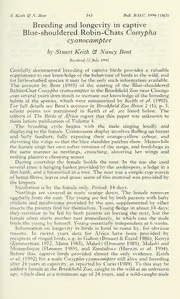
Breeding and longevity in captive Blue-shouldered Robin-Chats Cossypha cyanocampter PDF
Preview Breeding and longevity in captive Blue-shouldered Robin-Chats Cossypha cyanocampter
& 5. Keith N. Bent 143 Bull. B.O.C. 1996 116(3) Breeding and longevity in captive Blue-shouldered Robin-Chats Cossypha cyanocampter & by Stuart Keith Nancy Bent Received25July 1995 Carefully documented breeding of captive birds provides a valuable supplement to our knowledge ofthe behaviour ofbirds in the wild, and for little-studied species it may be the only such information available. The account by Bent (1985) of the nesting of the Blue-shouldered Robin-Chat Cossypha cyanocampter in the Brookfield Zoo near Chicago over several years does much to increase our knowledge ofthe breeding habits of the species, which were summarized by Keith et all (1992). For full details see Bent's account in Brookfield Zoo Bison 2 (1), p. 3; salient points not mentioned in Keith et al. are listed below. The editors of The Birds of Africa regret that this paper was unknown to them before publication of Volume 4. The breeding cycle begins with the male singing loudly and displaying to the female. Commonest display involves fluffing up breast and belly feathers, fully exposing their orange-yellow colour, and shivering the wings so that the blue shoulder patches show. Meanwhile the female sings her own softer versions of the songs, and food-begs in the same manner as nestlings, crouching, shivering her wings and making plaintive cheeping noises. During courtship the female builds the nest. In the zoo she used several sites: a hanging basket provided by the zookeepers, a ledge in a dirt bank, and a bromeliad in a tree. The nest was a simple cup woven ofhemp fibres, leaves and grass; some ofthis material was provided by the keepers. Incubation is by the female only. Period: 14 days. Nestlings are covered in rusty orange down. The female removes eggshells from the nest. The young are fed by both parents with baby crickets and mealworms provided by the zoo, supplemented by other insects the parents find for themselves. Young fledge in about 14 days; they continue to be fed by both parents on leaving the next, but the female often starts another nest immediately, in which case the male feeds the young by himself. Young essentially independent at 6 weeks. Information on longevity in birds is hard to come by, for obvious reasons. In recent years data for Africa have been provided by recapture of ringed birds, e.g. in Gabon (Brosset & Erard 1986), Kenya (Zimmerman 1972, Mann 1985), Malawi (Dowsett 1985), Malawi and Mozambique (Hanmer 1989), and Zimbabwe (Harwin et al. 1994). Before this, captive birds provided almost the only evidence. Keith et al. (1992) list a male Cossypha cyanocampter still alive and breeding after 24 years in captivity, as reported by Curio (1989). To this may be added a female in the Brookfield Zoo, caught in the wild at an unknown age, which died at a minimum age of 24 years, and a wild-caught male & 5. Keith N. Bent 144 Bull. B.O.C. 1996 116(3) which died there at a minimum age of 19 years. Small passerines are being shown to live a good deal longer than was previously supposed. Keith et al. (1992) report a captive Common Bulbul Pycnonotus barbatus which lived for 26 years 5 months and a wild bird which lived for 18 years. In urban areas in Zimbabwe, on the other hand, where these bulbuls are taken by cats and other predators, mean life expectancy is only 2.02 years, with a maximum of 9.92 years (Irwin 1981). The Brookfield Zoo has been very successful in raising Cossypha cyanocampter. One pair produced a lifetime total of 12 fledged chicks, another pair 15 chicks. One female continued to breed until about age 20. This demonstrated ability to breed non-seed-eating passerines in captivity is very encouraging when one considers the number ofspecies that may soon come to depend on intervention by man for their survival. Cossypha cyanocampter is not at present endangered, although the forests it lives in are at risk, but many other small African thrushes survive in precariously low numbers. Acknowledgements We thank Karin Nelson, editor of TheBison, forallowing usto use some ofthe material from Nancy Bent'searlier(1985) paper. Bentalsowishes to thank Lucy Greer, Registrar at Brookfield Zoo, for her help in assembling data on the robin-chats, and the Bird Department at Brookfield Zoo for all their efforts at breeding the species. References: Bent, N. 1985. Blue-shouldered Robin-Chats. BrookfieldZoo Bison 2(1): 3. Brosset, A. & Erard, C. 1986. Les Oiseaux des Regions Forestieres du Nort-Est du Gabon. Vol. I. Societe Nationale de Protection de la Nature, Paris. Curio, E. 1989. Is avian mortality preprogrammed? Trends Ecol. Evol. 4: 81-82. Dowsett, R. J. 1985. Site fidelity and survival rates of some montane forest birds in Malawi, south-central Africa. Biotropica 17: 1—45-154. Hanmer, D. B. 1989. The Nchalo ringing station bird longevity and migrant return. Nyala 14: 21-27. Harwin, R. M., Manson, A. J., Manson, C. & Mwadziwana, P. 1994. The birds of the Bvumba Highlands. Honeyguide 40, Supplement No. 1. Irwin, M. P. S. 1981. The Birds ofZimbabwe. Quest Publ., Harare. Keith, S., Urban, E. K. & Fry, C. H. 1992. TheBirdsofAfrica. Vol. 4. AcademicPress. Mann, C. F. 1985. An avifaunal study in Kakamega Forest, Kenya, with particular reference to species diversity, weight and moult. Ostrich 56: 236-262. Zimmerman, D. A. 1972. The avifauna of the Kakamega Forest, western Kenya, including a bird population study. Bull. Am. Mus. Nat. Hist. 149, Article 3. Addresses: StuartKeith, 19356 LeeViewLane,Redding, CA96003, U.S.A. NancyBent, Brookfield Zoo, Chicago Zoological Society, Brookfield, IL 60513, U.S.A. © British Ornithologists' Club 1996
